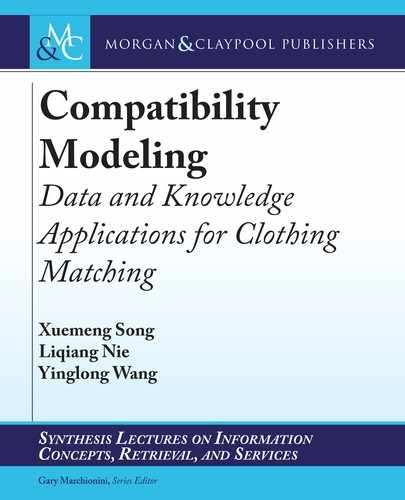
42 4. KNOWLEDGE-GUIDED COMPATIBILITY MODELING
In total, we have 1,954 unique tops in the testing set. Due to the sparsity of the real-
world dataset, we found there are 1,262 (64.59%) tops never appeared in S
train
. To comprehen-
sively evaluate the proposed model, we compared it with different models using different type
of testing tops: observed testing tops and unobserved ones. As can be seen from Figure 4.7,
AKD-DBPR and DBPR outperform all the other baselines consistently at different numbers
of bottom candidates in all scenarios, which demonstrates the effectiveness of our models in
complementary fashion item retrieval. In addition, AKD-DBPR and DBPR achieve satisfac-
tory performance with both observed and unobserved tops, which validates their capability of
handling the cold start problem. Last but not least, we found that AKD-DBPR outperforms
DBPR in both scenarios, especially with observed testing tops, which reconfirms the importance
of incorporating the domain knowledge. To have an intuitive understanding of the results, we
provided certain intuitive ranking results of AKD-DBPR and DBPR for testing tops in Fig-
ure 4.8. e bottoms highlighted in the red boxes are the positive ones. By checking the context
of each example, we found that they both activate certain matching rules, such as “floral C flo-
ral,” “coat C dress,” and “white C black,” which may contribute to the good performance of
AKD-DBPR.
0.55
0.50
0.45
0.40
0.35
0.30
0.25
0.20
0.15
0.10
0.05
0.55
0.50
0.45
0.40
0.35
0.30
0.25
0.20
0.15
0.10
0.05
5 10 15 20 25 30 35 40 45 50 55 5 10 15 20 25 30 35 40 45 50 55
T
(a) Observed testing tops. (b) Unobserved testing tops.
MRR
MRR
T
RAND
IBR
ExIBR
BPR-DAE
DBPR
AKD-DBPR
RAND
IBR
ExIBR
BPR-DAE
DBPR
AKD-DBPR
Figure 4.7: Performance of different models.
4.5 SUMMARY
In this chapter, we present an attentive knowledge distillation scheme toward compatibility
modeling in the context of clothing matching, which jointly learns from both the specific data
samples and general knowledge rules. Considering that different rules can have different confi-
dence levels to different samples, we seamlessly sew up the attention mechanism into the knowl-
edge distillation framework to attentively assign the rule confidence. Extensive experiments have
been conducted on the real-world Dataset I and the encouraging empirical results demonstrate
the effectiveness of the proposed scheme and indicate the benefits of taking the domain knowl-
edge into consideration in the context of compatibility modeling. We found that the negative

4.5. SUMMARY 43
Query 1 2 3 4 5 6 7 8 9 10
ADK-DBPRDBPRADK-DBPRDBPR
Figure 4.8: Ranking result illustration of AKD-DBPR and DBPR. e bottoms highlighted
in the red boxes are the positive ones. e first example activates the rules “floral C floral” and
“coat C dress,” while the second one triggers the rule “white + black.”
matching rules and category related rules seem to be more powerful than others. We also ex-
hibited the benefits of incorporating the attention mechanism into the knowledge distillation
framework. One limitation of our work is that currently we only rely on the contextual metadata
to identify the rules activated by the given sample, which is largely constrained by the incomplete
and noisy description.
..................Content has been hidden....................
You can't read the all page of ebook, please click here login for view all page.
